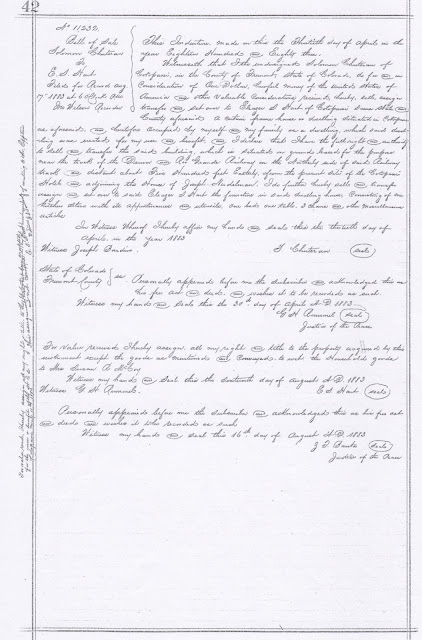I've been researching it ever since. I'd like to verify the location of the house today - if it still exists.
First, that original document found in the trash:
Another document that was pulled from the trash is the sale of the other half of the house, the Chuteran property, the same day. Interesting that this document was just one page.
11232
Bill of Sale
Solomon Chuteran to
W. S. Hart
Filed for Record Aug 7, 1883 at 6 o’clock pm
Jno Wilson Recorder
This indenture made on this the Thirtieth day of April in the year Eighteen Hundred and Eighty three.
Witnesseth that I the undersigned Solomon Chuteran of Cotopaxi, in the County of Fremont, state of Colorado, do for and inconsideration of One Dollar, lawful money of the United States of America and other valuable consideration received hereby, sell, assign, transfer and set over to Eleazer S. Hart of Cotopaxi, same state and county aforesaid a certain frame house or dwelling situated in Cotopaxi as aforesaid, and heretofore occupied by myself and my family as a dwelling which said dwelling was erected for my use and benefit and I delcare that I have the full right and authority to sell and transfer the said building, which is situated on grounds leased for the purpose near the track of the Denver and Rio Grande Railway on the northerly side of said railway track and distant about five hundred feet easterly, from the present site of the Cotopaxi Hotel and adjoining the House of Joseph Nudelman. I do further hereby sell and transfer assign and set over to said Eleazer S. Hart the furniture in said dwelling house, consisting of one kitchen stove with appurtenances and utensils, one bed, one table, 3 chairs and other miscellaneous articles.
In witness whereof I hereby affix my hand and seal this the thirtieth day of April, in the year 1883.
S. Chuteran
Witness Joseph Bardine
State of Colorado
Fremont County ss
Personally appeared before me the subscriber and acknowledged this as his free act and deeds, and wishes it to be recorded as such. Witness my ahdn and seal this the 30th day of April A. D. 1883. G. H. Rummel seal, Justice of the Peace
For value received I hereby assign all of my right and title to the property acquired by this instrument except the goods as mentioned and conveyed to with the household goods to Mrs Susan A McCoy.
Witness my hand and seal this the sixteenth day of August A. D. 1883 E. S. Hart, seal, Witness G. H. Rummel.
Personally appeared before me the subscriber and acknowledged this as his free act and deeds and wishes it to be recorded as such. Witness my hand and seal this 16th day of August A. D. 1883. Z. T. Banta seal, Justice of the Peace.
Down the left side of the page:
For value received I hereby assign all my right and title to the property acquired by this instrument of writing to Mr Epptein. This assignment has not been accepted, has not been conveyed. E. S. Hart, witness H. S. Tooling.
I have not been able to locate all of the documents that I am looking for but I do have some that refer to this as the "McCoy double house". As soon as I have a complete "trail" I will come back and update this post. But it appears that this was 2 families living under a common roof with a wall adjoining their residences...the houses were attached to each other.
It is also evident that the houses were built on land leased from E. H. Saltiel.
In my later documents, the land was sold by O. B. Carroll to A. A Sloan. Then Sloan sold the double house and the land to W. A. Hendricks. Hendricks sold it back to Sloan who sold it to Kate Gorman in 1895. I do not have documentation yet as to how it got to Carroll from McCoy.....or who it went to after Gorman.
Couldn't I just to a title search? No - that won't work for most of the houses in Cotopaxi. For most of the houses, sometime between 1910 and 1950...the owners all went to court to prove their ownership. And by doing such, they didn't have to go back and verify the earliest ownerships. They would stand on the court house steps in Canon City and literally call out every possible owner's name. No one showed up and the judge awarded the property to the current owner.
That or they simply had it re-declared under the Federal Land act.
And yes, this may be wasting my time, but I have to wonder. With these 2 documents are "new" questions.
1) Were the Nudelmans and the Chuterans related? People rarely lived this close together if they weren't.
2) Did both of these families leave Cotopaxi in April, 1883, when the houses were sold? Or had they built another house on the land they farmed that was south of Cotopaxi?
I have found no documents showing the sale of any of the plots south of Cotopaxi.
3) In both documents, the property was "sold" to E. S. Hart who then "sold" them to Susan McCoy. Was Hart acting as an early realtor in western Fremont county?
4) It does not appear that the furniture was transferred to McCoy.
5) This does tell us some of the furniture they had.
6) The sale was for $1 and "other valuable considerations." This is a common phrase used and could mean anything. Did they just want to dump the property? Was it worth nothing since they didn't own the land it was on. What would a 49 year lease be worth? How much would you give for a duplex that sat on a 49 year lease and you didn't know if the lease could be renewed or not?
7) Who did McCoy sell the place to?
Interesting questions!
One thing I do know is that neither Nudelman or Chuteran were listed on the miner's lien. It would be doubtful that Saltiel paid them and not the others. Thus, most likely, they did not owe Hart any money at his store.
These documents also show us that:
Joseph Bardine was a witness
G. H.. Rummel was the Justice of the Peace
Z. T. Banta was a justice of the Peace
and there was a Mr. Epptein
and a witness H. S. Tooling.
What were their relationships with the Colonists? with Saltiel? with Hart?
This is a prime example of how researching local documents can give you clues as to where to go next with your research, whether it is related to your family tree or not.
*********c2016Cotopaxi-Colony.blogspot.com All content is copyright protected and may not be copied, reproduced, reused or reposted in any manner without permission.


























